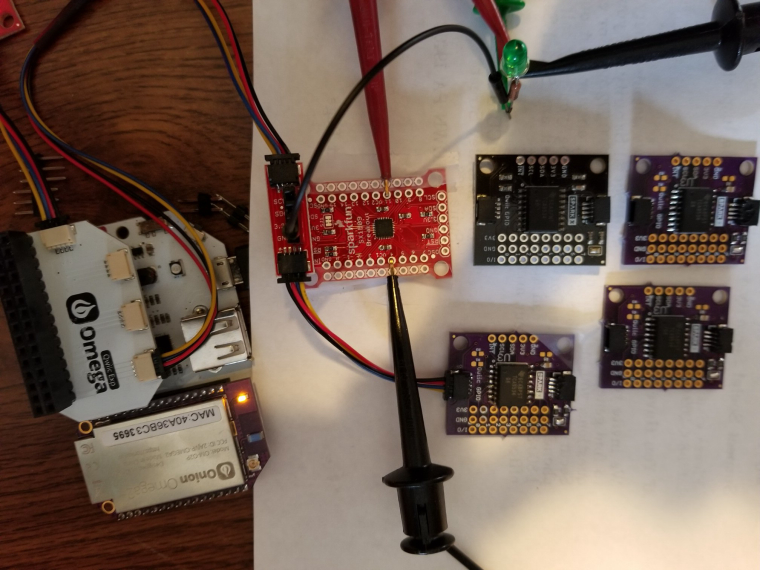Sparkfun I2C GPIO expanders
-
I needed extra GPIO pins, so I tried two of Sparkfun's I2C offerings. One is SparkFun 16 Output I/O Expander Breakout - SX1509, BOB-13601. By stacking a SparkFun Qwiic Adapter, DEV-14495, on top I connected the GPIO expander to the Omega Qwiic expansion as shown in the picture.
 . Driver software for this board and Python in the raspberry Pi environment is here: https://github.com/topherCantrell/pi-io-expander/find/master, which was easy to adapt for simple I/O. The Onion Omega Python-light version is here:
. Driver software for this board and Python in the raspberry Pi environment is here: https://github.com/topherCantrell/pi-io-expander/find/master, which was easy to adapt for simple I/O. The Onion Omega Python-light version is here:#!/usr/bin/env python # adapted from <https://github.com/topherCantrell/pi-io-expander/find/master> from OmegaExpansion import onionI2C #need >>opkg install python-light pyOnionI2C import time CHIP_A = 0x3E # I2C address for chip A, cut jumpers for other addresses SX_RegDirA = 0x0F # Data direction registers... SX_RegDirB = 0x0E # ...default 0xFF, 0 is output, 1 is input SX_RegDataA = 0x11 # Data value registers... SX_RegDataB = 0x10 # ...default 0xFF SX_RegPullDownA = 0x09 # Registers to enable pulldown resistors... SX_RegPullDownB = 0x08 # ... default 0x00, 0 is disabled, 1 is enabled bus = onionI2C.OnionI2C() #bus.writeByte(CHIP_A, SX_RegDirA, 0xFF) # That's the default, so not needed #bus.writeByte(CHIP_A, SX_RegDirB, 0xFF-8) # Just bit 11 as output. e.g. 1111 0111 bus.writeByte(CHIP_A, SX_RegDirB, 0xFF-0x09) # Set bits 8 and 11 as outputs, e.g. 1111 0110 bus.writeByte(CHIP_A, SX_RegDataB, 8) # Switch on pin 11 time.sleep(1) bus.writeByte(CHIP_A, SX_RegDataB, 0) # Switch p1n 11 off while True: bus.writeByte(CHIP_A, SX_RegDataB, 8) # Switch on pin 11 a = bus.readBytes(CHIP_A, SX_RegDataB, 2) print a[0], ',', a[1] time.sleep(0.2) bus.writeByte(CHIP_A, SX_RegDataB, 1) # Switch pin 11 off and pin 8 on a = bus.readBytes(CHIP_A, SX_RegDataB, 2) print a[0], ',', a[1] time.sleep(0.2) bus.writeByte(CHIP_A, SX_RegDataB, 0) # All off a = bus.readBytes(CHIP_A, SX_RegDataB, 2) print a[0], ',', a[1] time.sleep(0.2) print ' 'Another post describes a different GPIO expander.